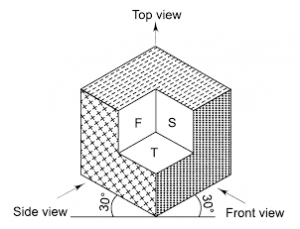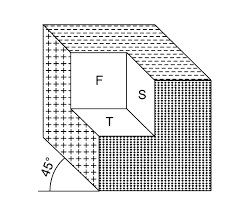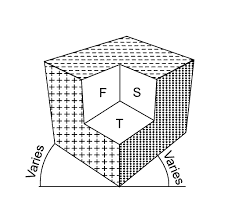This set of Machine Drawing Multiple Choice Questions & Answers (MCQs) focuses on “Method of Expression”.
1. Axonometric view is a type of _____________
a) Orthographic view
b) Pictorial view
c) Oblique View
d) Pictorial and Oblique View
View Answer
Explanation: Views are classified as pictorial and orthographic view and the pictorial view is classified into three subgroups namely perspective axonometric, oblique and orthographic views. Axonometric view is that type of pictorial view in which the line of site is perpendicular to the picture plane.
2. In an axonometric view, line of site are ______________
a) Perpendicular to plane of projection with all three faces equally inclined to picture plane
b) Perpendicular to plane of projection with all three faces need not be equally inclined to picture plane
c) Inclined to the plane of projection at certain angle
d) One face of the object needs to be parallel
View Answer
Explanation: An axonometric view is the type of pictorial view in which lines of the sight are perpendicular to the plane of projection. But all three faces need not be equally inclined to picture plane. The one with all three faces equally inclined to the picture plane is termed as isometric view.
3. The figure shown below depicts which type of view?

a) Oblique View
b) Perspective View
c) Axonometric View
d) Orthographic View
View Answer
Explanation: Since the line of sight is perpendicular to the face and face are inclined at some angle to the picture plane the given figure is drawn in axonometric view, in case of the oblique view one of the face is parallel to the picture plane however in case of the orthographic view line of site are parallel to the picture plane.
4. Which type of view is shown in the below figure?

a) Oblique View
b) Perspective View
c) Axonometric View
d) Orthographic View
View Answer
Explanation: Since one face is parallel to the picture plane and other face are inclined at some given angle thus the given figure best depicts oblique view. In case of perspective view edges appear to vanish at some distant point, in axonometric view line of site are perpendicular to the plane of a picture and orthographic view gives plane and elevation.
5. Which type of view best describes the view, of the below given figure?

a) Oblique View
b) Perspective View
c) Axonometric View
d) Orthographic View
View Answer
Explanation: Edges of the object are vanishing at some distant points and angle of inclination varies, thus the given figure is drowned in perspective view. Note that it can note be axonometric as a line of site are not perpendicular, it cannot be oblique as none of the face is parallel to picture plane and cannot be orthographic view as orthographic view gives only one face at one time.
6. In which of the following view the vanishing point is assumed to be located at infinity?
a) Perspective view
b) Orthographic view
c) Axonometric view
d) Perspective with one face of object parallel to the plane of picture
View Answer
Explanation: Axonometric view drawn in such a way that the faces if an object is perpendicular to the line of sight and thus the vanishing rays are parallel and hence vanishing point are at infinity, in orthographic view there is no matter of vanishing point. A perspective view always meant to have a vanishing point at some point.
7. In which of the below given views, the picture plane is the same as the plane of the projection?
a) Pictorial view
b) Perspective view
c) Orthographic view
d) Oblique view
View Answer
Explanation: Since an orthographic view is drawn by projecting the faces of an object on the required plane, thus plane of projection is parallel to the picture plane and lie in the picture plane. Since pictorial view are always drown with more than one face at one time thus cannot have picture plane as the plane of projection.
8. Projectors are referred to______________
a) Plane of projection
b) Picture plane
c) Rays intersecting the corner and edges of the object
d) Line of site
View Answer
Explanation: Projectors are rays which intersect at the corner of an object and aligned along the edges of the object. They are not plane, so plane of projection and picture plane cannot be referred and line site is not known as projector.
9. A designer is looking to draw the side view of a car in perspective, which of the below given choice is the best?
a) Choosing vanishing points in the paper area
b) Choosing a single vanishing point at infinity
c) Choosing a three-point perspective
d) Choosing an orthographic view
View Answer
Explanation: Generally two point or one point perspective is used to draw a car in perspective drawing; three-point perspective is used in architectural drawing. Since here side view is required, choosing a single vanishing point at infinity is going to give the best view.
10. The principal plane chosen in an orthographic view of a machine drawing is/are ______
a) Horizontal, vertical and side plane
b) Horizontal and side plane only
c) Vertical and horizontal plane only
d) Only vertical plane
View Answer
Explanation: An orthographic view is drowned of the object using three main views i.e. top view, side view and a front view, so three principal plane is drown named horizontal, vertical and side plane. Top view is termed as plan, side view as profile and front view as elevation.
11. A pictorial view must show __________ of a machine.
a) All the details necessary for its construction
b) The outside appearance
c) True shape of the machine
d) All the faces of the machine
View Answer
Explanation: A pictorial view is a view which is seen from an angle such that its three faces are visible. It shows only the outside appearance of a machine. It does not always show all the details necessary for its construction. It may not show even the true shape of the machine.
12. Side view is drawn by viewing from either the left or right side, whichever is __________
a) Easy to read
b) Suitable to draw
c) Having longest dimensions
d) More informative
View Answer
Explanation: Side view could either be from the left or right side depending upon which side gives more details. Two side views can also be given if one side view does not cover all the details.
13. In perspective view, the object can be inclined at ______ angle.
a) 300
b) 450
c) 600
d) Any
View Answer
Explanation: In perspective view, the object can be inclined at any angle. Generally, axonometric view is drawn at 300 and oblique view is drawn at 450.
14. For a cylinder, minimum views required for describing the shape are ____________

a) Three
b) Two
c) One
d) Four
View Answer
Explanation: The object shown in the figure is symmetric about its axis. For symmetrical objects, 2 views are mostly sufficient to describe the shape.
15. The method of ________ projection is universally adopted for the purpose of engineering drawing.
a) Orthographic
b) Isometric
c) Oblique
d) Perspective
View Answer
Explanation: By the orthographic projection method the description of the object regarding its shape and size is conveyed in such definite and unmistakable terms that it can be constructed as required. Isometric, Oblique and Perspective projection methods give the pictorial view, which shows only the outside appearance of a machine.
16. Single view may be enough to describe the shape of _______
a) Thick objects
b) Thin objects
c) Symmetric objects
d) Vertical objects
View Answer
Explanation: For thin objects, one view is sufficient to describe the shape. Minimum two to three views are required for describing shape of the thick, symmetric and vertical objects.
17. Sectional views can be drawn to show the ____________
a) Hatching lines
b) Outside views
c) Internal details
d) Symmetric objects
View Answer
Explanation: Sectional views are sometimes drawn to show the internal details, which are not possible in outside views. These sectional parts are shown by hatching lines.
18. While drawing an object on paper, which of the following method is not suitable regarding to its size?
a) Enlarge suitably if it is too small
b) Reduce if it is bigger than the paper size
c) Always should be drawn of the same size
d) Drawn of the same size if it can be accommodated on the paper
View Answer
Explanation: It is not always possible to draw the object of given size. It is to be enlarged or reduced in size suitably for easy readability.
19. Which of the following is not a subtype of pictorial view?
a) Cabinet view
b) Auxiliary section view
c) Cavalier view
d) 3 vanishing point view
View Answer
Explanation: Auxiliary section view is a type of section view. Cabinet view, Cavalier view and 3 vanishing point view are the subtypes of pictorial view.
20. _______ is an object seen by a human eye.
a) Perspective view
b) Axonometric view
c) Orthogonal view
d) Isometric view
View Answer
Explanation: An object seen by a human eye is perspective view. In an orthographic view, the object is seen from different directions. The object is first rotated in horizontal plane about vertical axis to make an angle with the picture plane in Isometric view, which is a type of axonometric view.
Sanfoundry Global Education & Learning Series – Machine Drawing.
To practice all areas of Machine Drawing, here is complete set of 1000+ Multiple Choice Questions and Answers.
If you find a mistake in question / option / answer, kindly take a screenshot and email to [email protected]
- Check Machine Drawing Books
- Practice Metallurgical Engineering MCQs
- Apply for Mechanical Engineering Internship
- Check Metallurgical Engineering Books
- Check Mechanical Engineering Books
